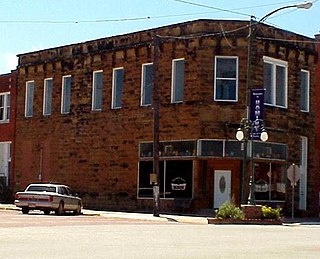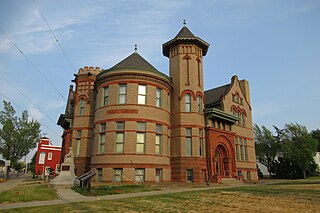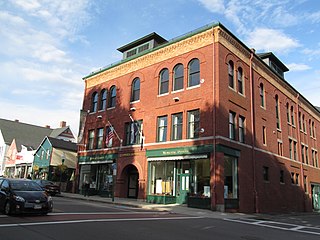
Romanesque Revival is a style of building employed beginning in the mid-19th century inspired by the 11th- and 12th-century Romanesque architecture. Unlike the historic Romanesque style, Romanesque Revival buildings tended to feature more simplified arches and windows than their historic counterparts.

The Oregon Commercial Historic District is a historic district in Oregon, Illinois, that has been listed on the National Register of Historic Places since 2006. The district is roughly bordered by Jefferson, Franklin, 5th and 3rd Streets in Oregon. It is one of six Oregon sites listed on the National Register and one of three to be so listed since the turn of the 21st century. The other two are the Oregon Public Library, listed in 2003, and the Chana School, listed in 2005.

Old Main, at 400 East Tyler Mall on the Tempe campus of Arizona State University, is the oldest building on the campus. It was built in 1898 and was designed by W. A. McGinnis in the Victorian Queen Anne style with Richardsonian Romanesque influences. Along with the Administration/Science Building and a third building no longer extant, Old Main defined the first quad on the campus of the Arizona Territorial Normal School; Arizona would not become a state for 14 years after Old Main was dedicated.

The Dekum or the Dekum Building is a historic office building in downtown Portland, Oregon, United States. It was listed on the National Register of Historic Places in 1980.

The Bank of Hominy, at W. Main St. and S. Price Ave. in Hominy, Oklahoma, is a building constructed in 1906, two years after the Oklahoma oil boom of 1904. It is one of four small bank buildings built in Richardsonian Romanesque style in Osage County, Oklahoma during 1904–1911. The others are Bank of Burbank, Bank of Bigheart, and Osage Bank of Fairfax.

Ware Town Hall is a historic town hall at Main and West Streets in Ware, Massachusetts. It was built in 1885 to a design by the architectural firm of Hartwell and Richardson, and is a prominent local example of Romanesque Revival architecture. The building, enlarged in 1904 and 1935 with stylistically sensitive additions, was listed on the National Register of Historic Places in 1986.

Waldschmidt Hall is an academic building at the University of Portland in Portland, Oregon, United States. Constructed in 1891 as West Hall, the building was originally part of the now defunct Portland University located in North Portland overlooking the Willamette River. The Romanesque style structure built of brick and stone stands five stories tall. The hall was added to the National Register of Historic Places in 1977 and renovated in 1992, the same year it took the current name. Waldschmidt, the oldest building on campus, now houses the school's administration offices and some classrooms.

Frederick Manson White, commonly known as F. Manson White, was an American architect based in Portland, Oregon. White was known for his work in the Richardsonian Romanesque style. Among the buildings he helped design, as part of the firm McCaw, Martin and White, or designed as a sole practitioner, are several that are on the National Register of Historic Places. These include the Imperial Hotel, Waldschmidt Hall at the University of Portland, the Dekum Building, the Auditorium and Music Hall, the Sherlock Building, the Flatiron Building, Woodrow Wilson Junior High School and the John G. Shedd Institute for the Arts in Eugene, the First Presbyterian Church in Medford, and the Corvallis Hotel in Corvallis. White also designed Agate Hall on the campus of the University of Oregon, and the Central Presbyterian Church in Portland.

The U.S. Courthouse & Federal Office Building, Milwaukee, Wisconsin is a post office, Federal office, and courthouse building located at Milwaukee in Milwaukee County, Wisconsin. It is a courthouse for the United States District Court for the Eastern District of Wisconsin.

The Adrian Public Library is a historic structure located at 110 East Church Street in downtown Adrian, Michigan. Originally used as a library, it was designated as a Michigan Historic Site on December 14, 1976, and later listed on the National Register of Historic Places on December 6, 1977. It is located within the Downtown Adrian Commercial Historic District and adjacent to the Adrian Engine House No. 1. Today, the building houses the Lenawee County Historical Society Museum.
Frederick Sterner (1862–1931) was a British-born American architect, who designed large residential and commercial buildings in Colorado and New York City. Many of his structures are listed on the National Register of Historic Places.
John Wesley Ross was an architect in Davenport, Iowa. Originally of Westfield, Massachusetts, Ross moved to Davenport in 1874 where he designed several prominent structures. His son, Albert Randolph Ross, was a draughtsman in John W. Ross's office during 1884–7, and became a notable architect in his own right. Ross designed several buildings that are listed on the National Register of Historic Places (NRHP).

Eastern Michigan University Historic District is a historic district on the very south end of the Eastern Michigan University campus. Eastern Michigan University is a comprehensive, co-educational public university located in Ypsilanti, Michigan in Washtenaw County. The university was founded in 1849 as Michigan State Normal School. Several buildings since its founding have achieved historical significance and eventually establishing it on the National Register of Historic Places in 1984. The district was established in 1984.

The Hallock–McMillan Building, also known as the Hallock and McMillan Building, is the first and oldest commercial brick building in Portland, Oregon, located downtown at 237 SW Naito Parkway. The building was designed by Absalom Hallock and completed in 1857. It is adjacent to the Fechheimer & White Building. In 1975, it was listed as a "primary landmark" in the National Register of Historic Places (NRHP) nomination of the Portland Skidmore/Old Town Historic District, the building's designation subsequently "translated" to "contributing property" under post-1970s NRHP terminology.

Justus F. Krumbein was an architect based in Portland, Oregon, United States, whose work included Richardsonian Romanesque designs and Italianate, cast-iron architecture. Little of his work survived the 20th Century.

The Camden Opera House Block is a historic multifunction building at 29 Elm Street in the center of Camden, Maine, United States. Built in 1893 after the town's great 1892 fire, it is one of its most prominent buildings. It houses town offices, a social meeting hall, and a 500-seat theater. The building was listed on the National Register of Historic Places in 1986.

Memorial Hall is a historic meeting hall at South Main and Elm Streets in Windsor Locks, Connecticut. Built in 1890 as a memorial to the town's American Civil War soldiers, it has served for most of its existence has a meeting place for veterans' organizations, from the Grand Army of the Republic to the American Legion. It is also one of the town's finest examples of Romanesque architecture, and was listed on the National Register of Historic Places in 1987.

The Hugh Roy and Lillie Cullen Building is the central administration building of Southwestern University in Georgetown, Texas. Completed in 1900, the Cullen Building was declared a Recorded Texas Historic Landmark in 1962 and has been listed on the National Register of Historic Places since 1975, together with neighboring Mood-Bridwell Hall.

The K.A.J. and Cora Mackenzie House is a Richardsonian Romanesque revival style building in Northwest Portland, Oregon, situated on the corner of NW 20th Avenue and NW Hoyt Street, just blocks from its partner organization, the William Temple Thrift Store. Although the house is most well-known now for its association with the William Temple community, it was originally commissioned in 1891 by Kenneth A. J. Mackenzie, a medical professional in Oregon, and his wife, Cora Mackenzie, as their private residence. The Portland architecture firm of McCaw, Martin, and White was selected by the MacKenzies to design the house. The Mackenzies owned the house and resided in it until Kenneth A. J. Mackenzie's death in 1920, when it was sold. The house has had several owners since then, eventually being placed on the National Register of Historic Places in 1996. The house has three stories and is roughly 7,100 square feet. The Mackenzie house is a prominent example of the influence of the Richardsonian Romanesque Revival architectural style on the west coast.

Cathedral Historic District, originally the Sioux Falls Historic District, is located in Sioux Falls, South Dakota. Named for its centerpiece and key contributing property, the Cathedral of Saint Joseph, the district covers the neighbourhood historically known as Nob Hill, where multiple prominent pioneers, politicians, and businessmen settled in the late 19th and early 20th centuries. These homes primarily reflect Queen Anne and Mediterranean Revival architectural styles. In 1974, the neighborhood was listed as a historic district on the National Register of Historic Places (NRHP); at the time of this listing, there were 223 buildings, not all contributing, within the district's boundaries. The district was enlarged in 2023.




















